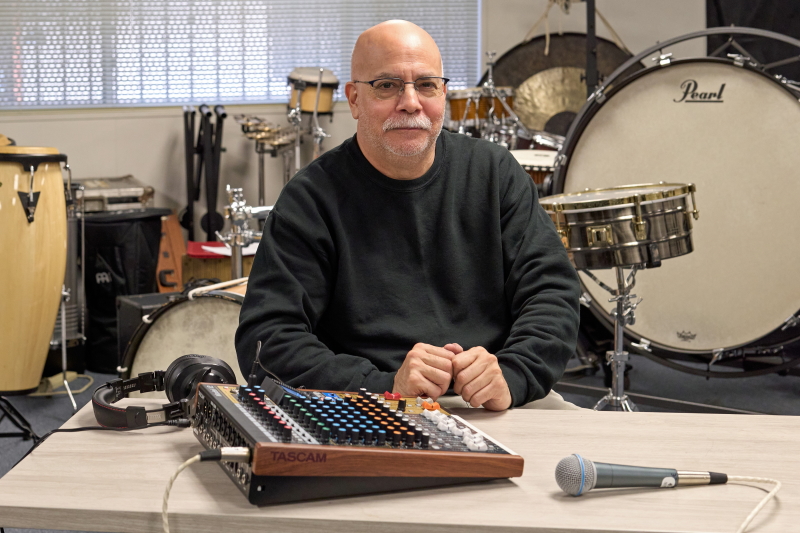Louie Teran uses TASCAM Model 12

For Louie Teran, Mastering Engineer / Instructor of Commercial Music at Long Beach City College, the necessity of moving among portable classrooms while a new Performing Arts complex is under construction brings a wealth of challenges. As recording studios are typically ‘fixed’ in terms of their placement and connectivity, regardless of whether the studio is in a room or a mobile vehicle, the ability to have enough functionality for teaching and demonstration purposes is no small challenge. To address these issues, Teran has come to rely on the wealth of features offered by the Model 12 12-Track Digital Recording Mixer with DAW Controller and Audio Interface from TASCAM.
Teran got his career start by working as a recording engineer at Skip Saylor Recording in Los Angeles before assuming mastering responsibilities with Marcussen Mastering in Hollywood. Over the years, Teran has achieved success at the highest levels. He has mastered multiple gold, platinum, and Grammy nominated albums, including The Dark Knight (2009 Grammy Award Best Score Album), Finding Neverland (2004 Academy Award Best Score), along with Marcus Miller's Afrodeezia 2016 Grammy Nominated album. When not teaching, he currently masters audio in his own Long Beach studio known as Haus of Sonics. He discussed his fondness for TASCAM’s Model 12 and how it fits into his teaching responsibilities.
“Currently, I am teaching a Music Recording Techniques class,” he reports. “I really enjoy teaching introduction / beginning classes because I believe it’s imperative that students have a solid foundation about the recording process. Not every student wants a career as a traditional recording engineer. Many of my students’ desire is to learn how to record, mix, and master for their own personal projects. I want to be able to help them succeed, regardless of what their goals are for the music industry. I’ve been using the Model 12 for three years now. It serves as the centerpiece for teaching signal ?ow and gain staging of a recording console. While my students may never see an analog tape machine in the future, they will encounter an analog console at some point, and the Model 12 provides this necessary level of experience.”
When asked about the Model 12’s key features that are particularly notable for his application, Teran pointed to the insert points on channels 1 and 2, “This is an extremely important feature that is overlooked on most interface boxes and entry level digital recorder / mixers. Most students have only used an interface box. They have never seen insert points. I can teach how to use inserts for recording with an external analog compressor and /or analog EQ.”
Teran was equally enthusiastic about the Model 12’s onboard multitrack recorder. “With its integrated multitrack recorder, there’s no need for a computer,” he explained. “I can teach gain staging for digital recording and how to use metering when recording. I can also teach drum recording with multiple microphones, all with just the Model 12. Further, having actual knobs, buttons, and faders to touch and move is in my opinion, essential for the learning process, especially for beginners.”
Teran added, “Equally important, being able to copy/move recorded audio from one track to another is critical, since only channels 1 and 2 have insert points. After recording a track on, for example, channel 1 (track 1) with an insert point, it can then be moved to another track. In doing so, you can now use channel 1 again to record with your external analog compressor or EQ.”
As for the types of devices commonly used in conjunction with the Model 12, Teran offered the following, “I teach how to interface all types of sources into the Model 12. This includes microphones (both dynamic and condenser), as well as guitar and bass via direct, line level inputs. I have also used the Model 12’s Bluetooth input for cell phones and have taught how to use the Model 12 as a multichannel interface into a computer. Further, I also show how to just use the insert return with an external mic pre to bypass the built-in console mic pre as a signal ?ow trick.”
Before turning his attention back to the business of the day, Teran offered these parting comments regarding his experience with the TASCAM Model 12, “Because the Commercial Music Program was brand new when I started teaching at LBCC, I would not have been able to instruct about multitrack recording without it. There were only 2 channel I/O boxes to record with at that time. With the console being as small and compact as it is, I didn’t have to worry about where I would be teaching each semester while the new Performing Arts Building is under construction. Also, I had no worries if the computer in the classroom I was teaching in had the recording software needed. The Model 12 being a stand-alone mixer/ multitrack recorder solved all those issues and has all the features I need to teach a student about recording through a console to a digital multitrack. It also has features that enable me to teach the basics of mixing on a console. The Model 12 has proven itself to be a compact and very capable recording system that has made my teaching situation considerably more manageable.
 How to resolve AdBlock issue?
How to resolve AdBlock issue?